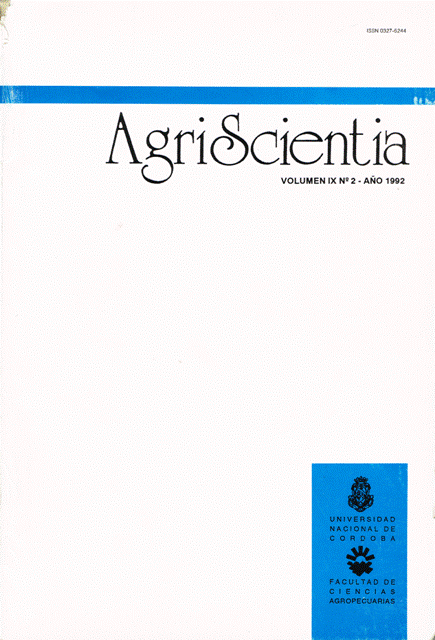Association of morphological characters in maize (Zea mays L.) populations under water stress and non water stress conditions
Main Article Content
Abstract
The association of different plant characters, under and without water stress conditions, was studied in one local and five exotic open-pollinated maize varieties, in field experiments during the summers of 1988/89 and 1989/90. A split plot design with three replications for each site was used. Genotypes were evaluated for yield and eleven characters. Correlation coefficients under water stress indicated that number of leaves, ear height, black layer maturity, senescence of ear leaf, prolificacy, interval between pollen shed and silking, plant height and grains per row significantly influenced grain yield. Under non-stress conditions, ear length, senescence of ear leaf, grains per row and prolificacy significantly influenced grain yield. Through path coefficient analysis, it was concluded that the improvement of drought tolerance can be achieved by using characters like the interval between pollen shed and silking, prolificacy, number of grains per row and senescence of ear leaf as selection criteria.
Article Details

This work is licensed under a Creative Commons Attribution-ShareAlike 4.0 International License.
How to Cite
References
Barnes, D. L., & Wolley, D. G. (1969). The effect of moisture stress at different stages of plant growth. I. Comparison of a single-eared and two-eared corn hybrid. Agronomy Journal, 61, 788-790.
Bolaños, J., Edmeades, G. O., & Martínez, L. (1990). Mejoramiento para tolerancia a sequía en maíz tropical: La experiencia del CIMMYT. XVIII Congreso Nacional de Maíz y Sorgo, Vittoria, ES, Brasil, 1-23.
CIMMYT. (1987). Programa de ensayos internacionales de maíz del CIMMYT. Informe Final 1987, CIMMYT, México, 331-335.
Fischer, K. S., Johnson, E. C., & Edmeades, G. O. (1984). Mejoramiento y selección de maíz tropical para incrementar su resistencia a la sequía. CIMMYT, El Batán, México. 20 pp.
Hall, A. J. (1984). Tolerancia a estrés hídrico en maíz: Bases morfológicas y fisiológicas. III Congreso Nacional de Maíz, Pergamino, Buenos Aires, Argentina, 11-23.
Hallauer, A. R., & Troyer, A. F. (1972). Prolific corn hybrids and minimizing risk of stress. 27th Annual Corn and Sorghum Research Conference, 27, 140-157.
Li, C. C. (1977). Path Analysis: A Primer. Boxwood Press. 347 pp.
Martiniello, P. (1983). Outline of the major components of maize breeding programs for semi-arid regions (Capitanata plain, southern Italy). Genetica Agraria, 37, 361-390.
Martiniello, P. (1984). Drought resistance in maize: Methods of detection and breeding considerations. Genetica Agraria, 38, 267-302.
Peiretti, D. A., Barrandeguy, M. A., Biasutti, C. A., & Salomon, N. (1987). Programa: Creaciones fitogenéticas en maíz con respuesta adaptativa a la zona marginal. En Primera Jornadas Nacionales de Zonas Áridas y Semiáridas, Santiago del Estero, Argentina, 345-349.
Shaw, R. H. (1977). Climatic requirement. En G. F. Sprague (Ed.), Corn and Corn Improvement (pp. 591-623). American Society of Agronomy.
Troyer, A. F. (1983). Breeding corn for heat and drought tolerance. En Proceedings of the 38th Annual Corn and Sorghum Research Conference, Chicago, Illinois, USA, 128-143.
Tyagi, A. P. (1988). Correlation and path coefficient analysis for yield components and maturity traits in maize. Plant Breeding Abstracts, 9373/1988.
Undersander, D. J. (1987). Yield and yield component response of maize to water stress in hybrids with different sources of stress tolerance. Maydica, 32, 49-60.
Vasal, S. K., Ortega, N., & Pandey, S. (1970). Population improvement and varietal development in CIMMYT's maize program. En Proceedings of the XVth Annual Meeting of Caribbean Food Crops Society (pp. 1-26).





